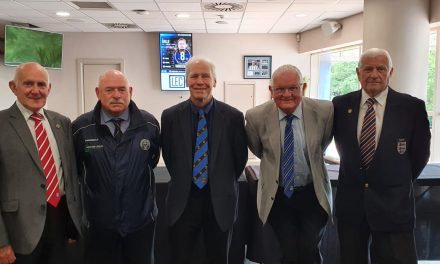Serial Yorkshire entrepreneur and philanthropist Prof Graham Leslie CBE – who was the driving force behind building the John Smith’s Stadium – has written a revealing autobiography and Huddersfield Hub has an exclusive first serialisation of it.
Graham was Huddersfield Town chairman in the early 1990s and had the vision and determination for Huddersfield to have the first all-seater football and rugby stadium in Europe – one which would be a trailblazer for the rest to follow.
He founded one of the UK’s most successful pharmaceutical companies, Galpharm – which went on to sponsor the stadium – and Graham later sold his business and has since dedicated his life to helping other businesses and charities.
Graham’s book, which marks 30 years since the first match at the ‘new’ stadium in 1994, is called Ahead Of The Curve and will, fittingly, be launched in the Terriers Together suite at the stadium on Friday, July 26, at 10.30am and anyone is welcome to attend. Town legends Andy Booth and Peter Jackson will be there and will sign copies of the book along with Graham.

Here’s what the book reveals about the time Graham was invited to join the Huddersfield Town board in the early 1990s after grumbling about Town struggling in the old Third Division – and the shock that awaited him.
At my first board meeting at Town I met my fellow board members for the first time – Keith Longbottom was an accountant, Charles Hodkinson a lawyer, Geoff Headey was a businessman and Leslie Thewlis, a lawyer and absolute gent who was involved in hospital radio and was the most supportive of my plans from the beginning.
The commercial director was Keith Hanvey who was a former player, there was a builder called Brian who helped with repairs around the ground and the final two board members were manager Eoin Hand and club secretary George Binns.
Turns out I’d been unfair to suggest the board didn’t know what they were doing. They had a tough job to do just to keep the club afloat and several had made personal guarantees on bank loans which is always risky but shows the lengths they’d go to try to preserve the club.
They had somehow kept the club going on the tightest of budgets for 15 years, thanks to Keith’s accountancy skills. In short, they’d run it on a shoestring.
After the meeting I asked why Eoin’s seat was next to the door in the boardroom and his name was written in chalk on the manager’s door.
“That’s because managers don’t tend to last long here,” came the reply.

There were things about the club that immediately concerned me.
Huddersfield Town was formed on August 15, 1908, at the Albert Hotel in Huddersfield town centre and for 80 years had been run like a gentlemen’s club to such an extent that no women were allowed in the boardroom at any time and on match days the wives and girlfriends of Huddersfield Town board members and those from the opposing team were herded into another room referred to as ‘the hen hutch.’
It’s clear head groundsman Ray Chappell loved his pitch with a passion to such an extent no-one was allowed on it – not even the players. He’d banned them from training on it so, in effect, playing at home was like playing away for them, especially new players.
I once organised a training session on the pitch and Ray was so incensed he phoned the chairman to order me off.
That had to change as the pitch at Town was convex so it was quite raised in the middle. This meant that when Eoin peered from his dugout, he couldn’t see part of his players’ legs on the other side of the pitch.
It also meant it was vital for them to train on the pitch to get used to the curve and turn it to their advantage over the opposition.
In the end Ray had to reluctantly agree to the team training on it twice a week, especially when I started to pay the bills to hold the bank off calling in personal guarantees from other board members.
Keith Hanvey was a very well respected former player and was trying to make Town a commercial success and was the first to moot the idea of building a new stadium.
But he felt he was getting nowhere with the board at the time so left in frustration and went to help Bradford City build a new stand as chief commercial executive before becoming commercial manager at Leeds United.
Like Keith, I was unhappy with the Leeds Road stadium. The toilets were a disgrace – brick-built outbuildings with a trough at foot level and some were even open air. The word ‘disgusting’ would be a positive description of them.
I think there was just one set of women’s toilets in the main stand.
But the final straw was the board meeting when George Binns said £10,000 was needed to repair The Cowshed roof which was falling to bits.
The Cowshed was the Town faithful’s strongpoint behind one of the goals. It had become so unsafe it had to be closed to protect the fans.
There was an awkward silence at the meeting due to the club’s financial plight and the decision was deferred.

It was the beginning of the end for the old Leeds Road stadium and the start of a new future.
The board saw the Cowshed roof as a disaster. I saw it as an opportunity. An opportunity to think big and go for a new stadium. What was the point trying to maintain a crumbling old ground?
The Taylor Report on the Hillsborough disaster had just come out too and all-seater stadia were the way forward.
I decided Town must have the first purpose-built all-seater stadium in the UK. Safety had to come first and the old Town ground was crumbling so I set about my quest to build one that would attract the right investors, good footballers, family supporters and staff. It was also to be something for the entire community and set a whole new standard in stadium construction.
It was to be a far rockier road than I could ever have imagined.
I was virtually laughed at by everyone at the club – especially as it was about £700,000 in debt at the time – and that’s when everyone’s different agendas came to the fore.
The manager wanted money for new players, Keith Longbottom and George Binns wanted to make the old ground safe in the aftermath of the Bradford City fire in 1985 which claimed 56 lives and left around 265 injured, Ray Chappell wanted more money for his hallowed turf and, although commercial revenue was growing, it needed taking to another level.
Several First Division clubs had built new stands at their grounds but no-one had built a new ground from scratch. To my mind it was the only way forward.
Fans celebrate Huddersfield’s Town’s old Leeds Road ground 30 years on



















